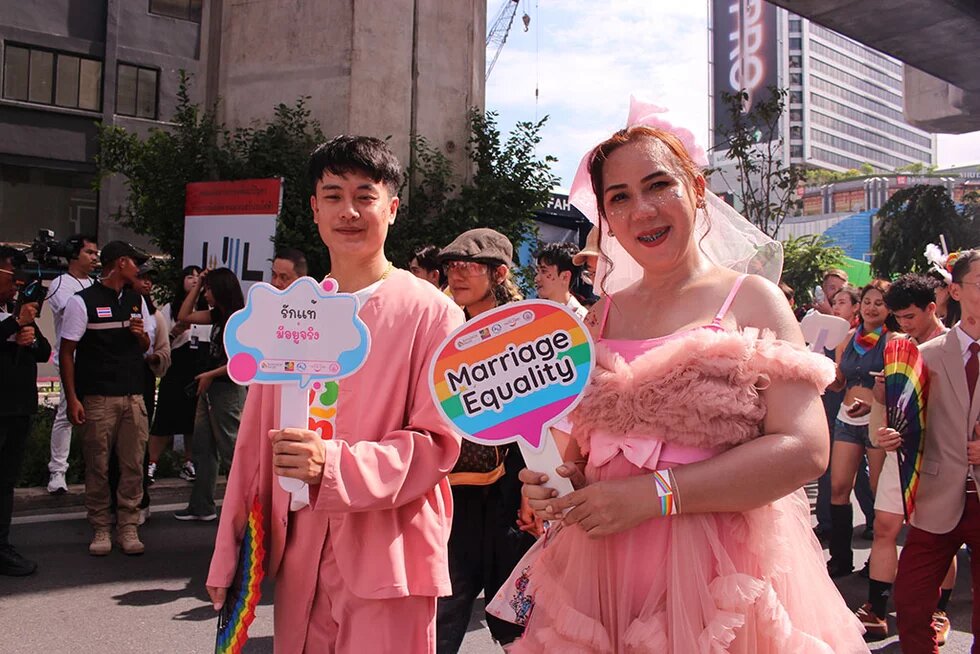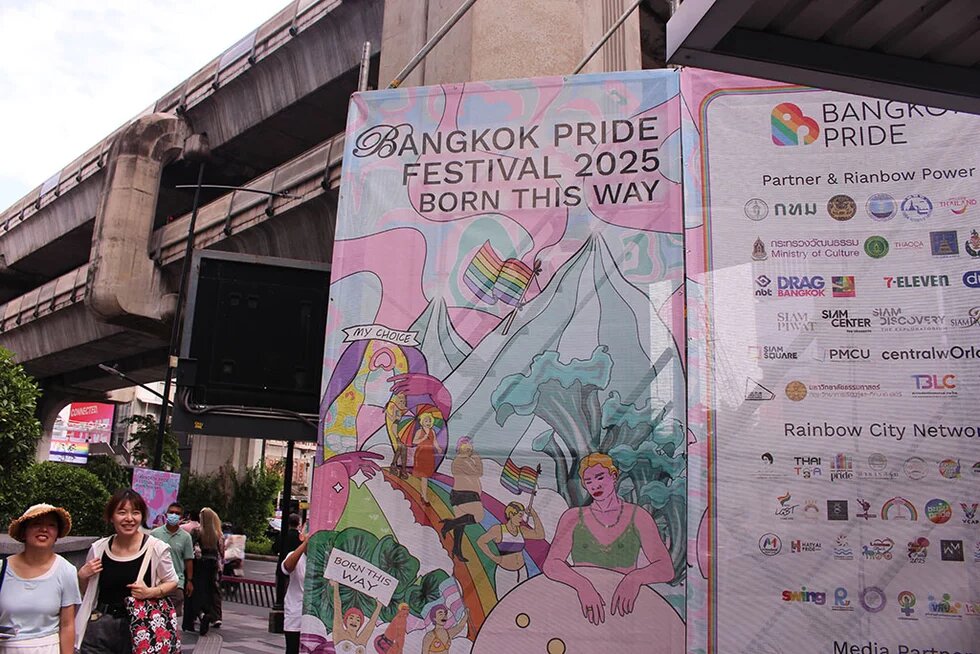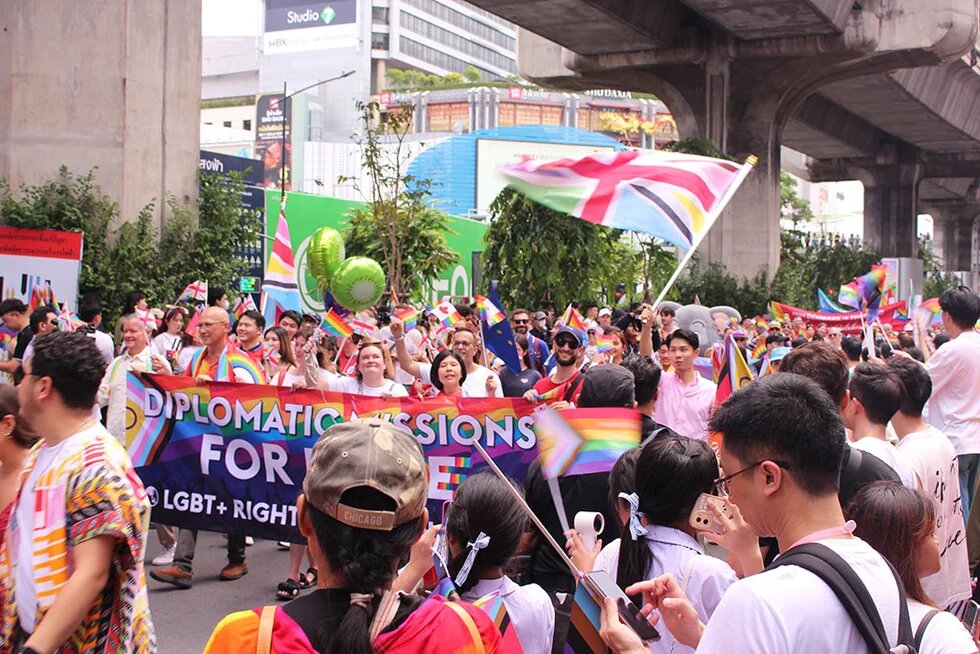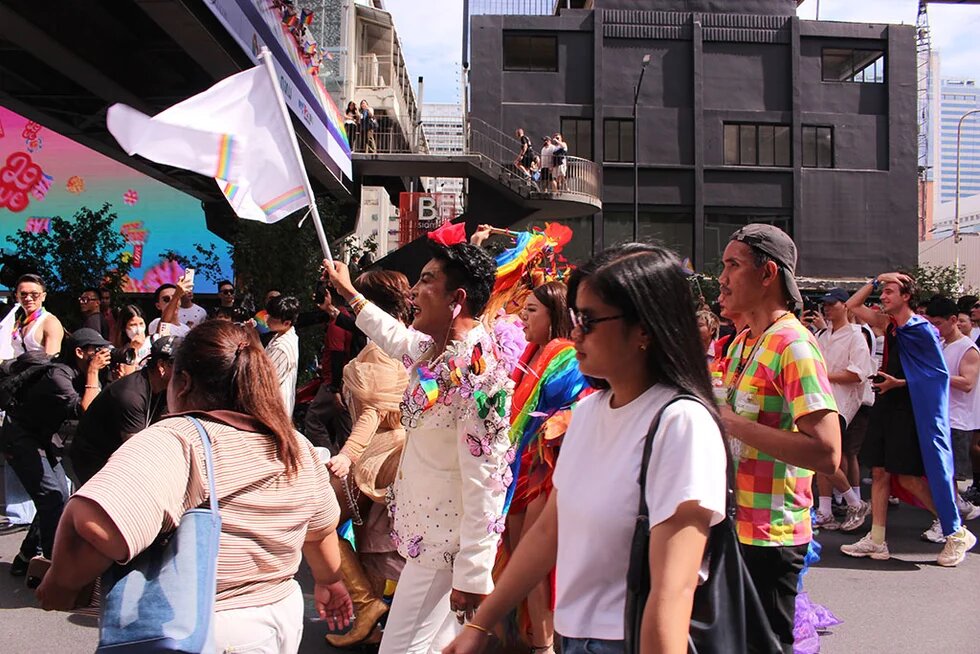
From bold parades to quiet acts of resistance, Pride in Southeast Asia reflects diverse local realities and carries layered meanings – from political activism and visibility to celebration and community. As Pride becomes more mainstream, deeper tensions emerge around commercialization and whose voices are heard. Yet across the region, uneven progress on LGBTQIAN+ rights and acceptance underscores how much more remains to be done, calling attention to the broader structural changes still urgently needed.
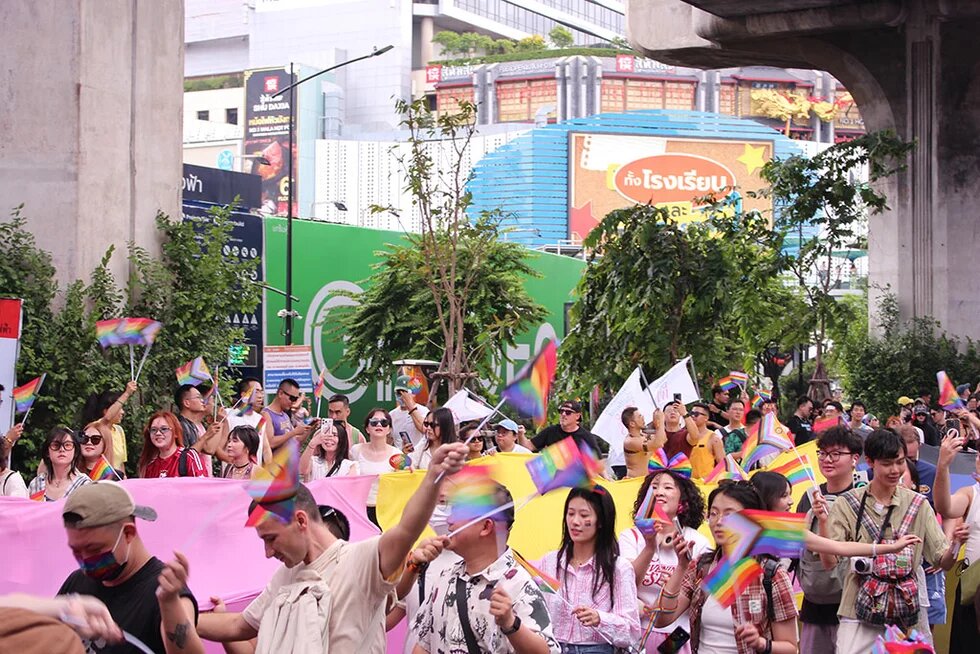
Pride in Southeast Asia is as diverse as the region itself. Rooted in global movements for lesbian, gay, bisexual, transgender, queer, intersex, asexual, and non-binary (LGBTQIAN+) rights – most notably the 1969 Stonewall uprising in New York – Pride today unfolds across the region in many forms: street marches, defiant protests, quiet gatherings, and other adaptive expressions. While Pride events happen year-round, June remains a key moment for LGBTQIAN+ visibility and resistance. This piece highlights developments particularly visible during this time, while recognizing it does not cover the full landscape of Pride. Examples may lean toward certain countries, reflecting where events are more publicly documented or legal and social shifts have drawn attention.
Revisiting key Pride moments – past and present – offers insights into how Pride in Southeast Asia has evolved, the tensions it navigated, and the meanings it continues to carry. As visibility expands, Pride also faces growing challenges particularly around commercialization and whose voices are amplified. These complexities invite reflection on what marching forward requires both within Pride itself and through the broader structural changes still urgently needed across the region.
Multiple Firsts, Many Forms: Diverse Landscape of Pride
Pride marches in Southeast Asia have taken diverse forms with different timelines. In the Philippines, Metro Manila Pride stands out for its scale and historical significance. The country is home to Asia’s first documented Pride march, held in 1994, though earlier activism such as campus organizing and feminist-aligned protests laid critical groundwork. As scholar notes, viewing LGBTQIAN+ history through “multiple firsts” offers a more inclusive narrative – a framing relevant across the region. In Thailand, for instance, Pride has a more interrupted trajectory. After multiple early iterations were sidelined or disrupted for nearly 16 years, Pride returned to Bangkok in 2022 with strong calls for marriage equality.
In countries where LGBTQIAN+ visibility is more cautiously emerging, Pride takes on more modest or adaptive forms. Cambodia’s Pride began in 2003 as a one-day event and expanded into a week-long celebration from 2009 onward. Vietnam’s Pride began in 2012 with a bike rally through Hanoi and has since expanded to multiple cities through film screenings, workshops, and smaller-scale marches. Timor-Leste joined the regional wave in 2017, holding a government-supported Pride march in Dili. Myanmar experienced limited windows of openness before the 2021 military coup, hosting creative events like a Pride boat parade.
While many Pride events take the form of marches, varying degrees of political freedom and social acceptance have led to localized expressions in some countries. In Laos, community groups have gradually gained state tolerance by aligning Pride with themes like public health and inclusion. Singapore’s annual Pink Dot, launched in 2009, reimagines Pride through non-confrontational public gatherings – neither parade nor protest – as a strategic response to strict government restrictions. In more restrictive contexts, Pride remains largely underground. In Malaysia and Brunei, even Pride-themed private gatherings face scrutiny or are banned outright, while in Indonesia, queer expression is often embedded within broader movements to avoid targeted backlash. Rather than mirroring global models, Pride here reflects strategic reimagining of visibility within specific cultural, social, and political realities. Ultimately, Pride is global in spirit but local in form, shaped by shared spirits and diverse lived realities.
Claiming Joy, Demanding Justice: The Many Purposes of Pride
Pride has always been political from its origins at Stonewall and this holds true in Southeast Asia. It often functions as a channel for political activism. In the Philippines, recent Baguio and Southern Tagalog Pride marches highlighted calls for the long-delayed SOGIESC Equality Bill, justice for trans victims, and stronger anti-discrimination protections. Despite setbacks and ongoing violence, activists emphasized that Pride is rooted in lived struggles from school exclusion to state neglect. Beyond parades, forums and performances became spaces to educate, resist, and build solidarity.
A similar dynamic has played out in Thailand. Revived as Bangkok Naruemit Pride in 2022, the event coincided with the introduction of draft bills on marriage equality and civil partnerships. Pride became a rallying point for public engagement, including a nationwide petition that drew broad support. Although those bills stalled, momentum continued. By mid-2024, Thailand’s long fight for marriage equality reached a milestone: the Marriage Equality Bill passed all readings, making it the first Southeast Asian country to legalize same-sex marriage. The victory reflected over two decades of collective efforts. Pride helped sustain that momentum, but legal change came from collective, sustained advocacy – of which Pride is a visible, but not solitary, force.
Pride asserts LGBTQIAN+ visibility in predominantly heteronormative societies. In societies where LGBTQIAN+ people are often pushed to the margins, being seen openly and proudly is a radical act that challenges stigma and fosters acceptance. Pride is also literally a festive celebration of pride. Even where political demands remain central, the tone can be one of hope and joy. That joy is political too – an unapologetic refusal to be shamed or silenced, as seen in the festive marches of Southern Tagalog despite legislative setbacks, or in Thailand’s colorful celebrations amid advocacy. It reclaims public space not only for protest, but for pleasure and community. To celebrate openly is to assert the right to exist, to belong, and to do so with dignity. Conclusively, the meanings of Pride are complex. They differ across contexts, within the same parade, and even for individual participants. For some, Pride is a celebratory event, or even as a tourist spectacle; for others, it remains a protest. All are valid. Pride holds multiple truths at once.
Pride for Whom? Commercial Parades and Struggles for Voices
As Pride has expanded from grassroots gatherings into large-scale annual festivals, tensions have emerged particularly around commercialization and so-called "rainbow-washing." Many worry that the spirit of Pride is being overshadowed. In Southeast Asia, corporate sponsorship is increasingly visible. Bangkok Pride 2024, for instance, featured Thailand’s largest business conglomerate as one of sponsors, sparking a debate. Some see such partnerships as inevitable, given the limited resources of grassroots groups to cover rising logistical costs. Others, including local advocate and civil society organization, argue that Pride should remain community-led, rooted in solidarity, and accountable to those most affected by LGBTQIAN+ struggles. Bigger isn’t always better, especially when scale compromises authenticity. Corporate sponsors often dominate the spotlight, shifting attention away from marginalized voices.
This is closely tied to concerns about rainbow-washing: when companies use LGBTQIAN+ symbols superficially during Pride month without offering real support or inclusive policies for LGBTQIAN+ employees. Critic argues that this form of performative allyship exploits LGBTQIAN+ struggles for marketing gain, providing symbolic support while avoiding any structural commitment. It reflects a broader shift from Pride as protest to product, from march to merchandise, commodifying LGBTQIAN+ identities and struggles. This shift prompts deeper questions about whose voices are heard and whose stories remain absent from the parade.
At the same time, many Pride events in Southeast Asia have grown more inclusive, bringing visibility to a wider range of identities and intersectional issues. Where representation was once limited, today’s marches affirm diverse communities. Yet this inclusivity remains uneven. Though trans communities, sex workers, and queer people with disabilities are more visible at Pride, their struggles are still overlooked, underrepresented, or met with controversy. Thai queer disability activists, noted in a report that accessibility remains a challenge not just during marches, but at related advocacy and social events. In another case, a banner at Bangkok Pride 2025 calling for legal gender recognition for trans people triggered online backlash, revealing how, even after marriage equality, full legal rights and social acceptance remain out of reach.
Marching Forward: Challenges That Remain and the Work Ahead
While has grown in parts of Southeast Asia, LGBTQIAN+ communities across the region continue to face significant legal and social challenges. Progress is uneven, and in some countries, protection remains limited or even nonexistent. Singapore’s repeal of its ban on sex between men was offset by a constitutional amendment blocking same-sex marriage, and its recent workplace anti-discrimination law excludes LGBTQIAN+ protections. In Myanmar, the military coup has intensified violence and discrimination against LGBTQIAN+ people, reversing past progress and leaving them highly vulnerable. In Islamic countries like Indonesia, Malaysia, and Brunei, rights remain tightly by religious and political forces. While Indonesia does not criminalize same-sex relations nationally, vague laws and Sharia-based local such as in Aceh enable discrimination and arrests. Malaysia explicitly criminalizes same-sex acts and gender non-conformity under both civil and Sharia law. Brunei enforces some of the harshest penalties in the region under its Sharia Penal Code. Even in countries where legal progress has occurred, much more remains to be done especially in improving social acceptance, which is essential to addressing the stigma that continues to fuel discrimination against LGBTQIAN+ communities.
Pride, while vital, cannot dismantle these entrenched barriers alone. Robust legal frameworks are essential, not only for protection, but to affirm LGBTQIAN+ rights in all aspects of life: family recognition, social protection, labor rights, inclusive education, freedom of expression and assembly, and gender recognition. These must be backed by comprehensive anti-discrimination laws that explicitly include gender diversity. At the same time, public education and awareness-raising are critical to challenge stigma, shift public attitudes, and counter harmful media portrayals. In a region where progress remains uneven and resistance persists, the spirit of Pride – as a force for political activism, visibility, and celebration – must be matched by bold reforms, inclusive policies, and sustained cultural change that affirms the dignity and rights of all LGBTQIAN+ people.
Marching forward, Pride offers more than a moment. It is part of ongoing movements and struggles for rights and dignity. Across the region, it carries the potential to support broader efforts for legal protection, social acceptance, and structural change. Sometimes quiet, sometimes defiant, Pride shows both how far we have come and how much further we must go, especially when LGBTQIAN+ communities along with allies move forward together. The road ahead demands more than a moment in June. It calls for the enduring true spirit of Pride to shape each day and fuel every struggle beyond Pride Month.
__
Lattapol Jirapathomsakul is a queer feminist advocate and researcher whose work explores diverse themes related to gender and sexuality.
Disclaimer: This published work was prepared with the support of the Heinrich Böll Stiftung. The views and analysis contained in the work are those of the author and do not necessarily represent the views of the foundation. The author is responsible for any liability claims against copyright breaches of graphics, photograph, images, audio, and text used.
